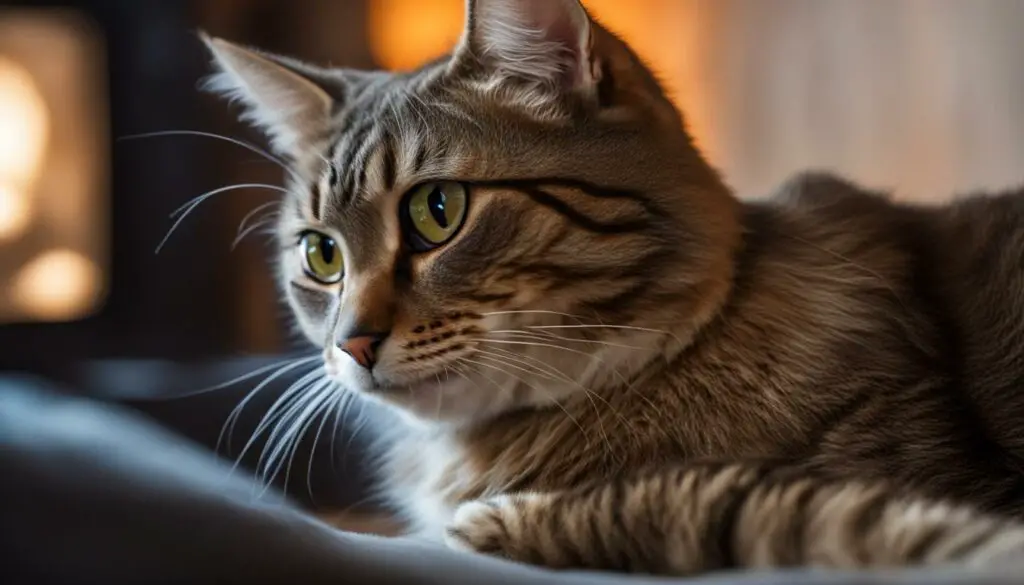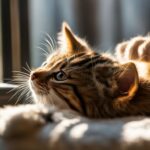As a cat owner, you may have noticed that your furry friend craves constant attention and affection. But have you ever wondered why your cat wants to be petted all the time? It turns out, there’s a fascinating reason behind their insatiable need for love and attention.
Cats have unique behaviors that set them apart from other pets. Their desire for affection and attention stems from their deep-rooted feline love and their inherent need for companionship. Understanding their behavior and deciphering their expressions of love can help strengthen the bond you share with your cat.
Key Takeaways:
- Cats crave constant petting and attention due to their deep-rooted feline love.
- Understanding cat behavior can help strengthen the bond between you and your feline friend.
- Deciphering their expressions of love, such as purring and kneading, is essential in nurturing the relationship.
- Cats seek companionship and emotional connection with their owners.
- Providing love, attention, and respect for their personal space is vital for a harmonious relationship with your cat.
What is Cat Imprinting?
Cat imprinting is a fascinating phenomenon that goes beyond basic affection between a cat and its owner. It is a deep emotional bond that forms between a feline and a human, resulting in unique behaviors and signs of attachment.
Unlike general cat affection, which can be observed in various pet-owner relationships, cat imprinting is characterized by a strong and lasting emotional connection. When a cat imprints on its owner, it becomes deeply attached and relies on the human for emotional support and companionship.
This emotional connection can manifest in different ways. Imprinted cats often display behaviors such as following their owners around the house, demanding attention, and showing distress when separated. These actions signify the cat’s strong bond and need for constant interaction with its human companion.
Understanding cat imprinting is crucial for cat owners, as it allows them to recognize and appreciate the unique bond they share with their feline friends. By nurturing this emotional connection and providing love and companionship, cat owners can ensure a fulfilling relationship for both themselves and their beloved pets.
| Behavior | Explanation |
|---|---|
| Following the owner | Imprinted cats often stay close to their owners, showing a strong desire for their presence. |
| Demanding attention | Imprinted cats may actively seek attention from their owners, seeking physical contact and interaction. |
| Distress when separated | Imprinted cats can become visibly upset when their owners leave, displaying signs of anxiety and longing. |
These behaviors, among others, are signs of the deep emotional connection formed through cat imprinting. By recognizing and responding to these behaviors, cat owners can strengthen their bond with their feline companions and provide them with the love and attention they need.
Remember, cat imprinting is an extraordinary bond that requires understanding and nurturing. It is a testament to the unique emotional connection that can exist between humans and cats.
Understanding Cat Body Language
Cats are mysterious creatures, often communicating through subtle body language cues. To truly understand your feline friend, it’s crucial to decipher their gestures and expressions. Cat body language provides valuable insights into their affection, behavior, and overall well-being.
Purring: A Sign of Contentment
One of the most recognizable cat behaviors is purring. Cats often purr when they’re content, feeling safe, or seeking attention. It’s their way of expressing happiness and relaxation. When your cat purrs, it’s a clear indication that they’re comfortable and enjoying your presence.
The Language of Tail Movements
A cat’s tail can convey a range of emotions. A straight, upright tail usually signifies confidence and a friendly attitude. On the other hand, a puffed-up tail indicates fear or aggression. When your cat’s tail is gently swishing from side to side, it may mean they’re feeling playful or excited. Paying attention to tail movements can help you gauge your cat’s mood and respond accordingly.
Eye Expressions and Ear Positions
The eyes and ears of a cat can reveal a lot about how they’re feeling. Dilated pupils often suggest excitement or arousal, while constricted pupils may indicate fear or anxiety. Cats also use their ear positions to communicate. Erect ears facing forward typically show interest, while flattened or backward-facing ears signal aggression or fear. Understanding these visual cues can help you better interpret your cat’s emotions and provide appropriate care and comfort.
| Body Language | Meaning |
|---|---|
| Tail held high | Confidence and friendliness |
| Puffed-up tail | Fear or aggression |
| Dilated pupils | Excitement or arousal |
By observing your cat’s body language, you can deepen your bond and provide a nurturing environment. Remember to approach your cat with patience and respect their boundaries. Building a strong connection based on understanding and mutual respect is key to fostering a loving relationship with your feline companion.
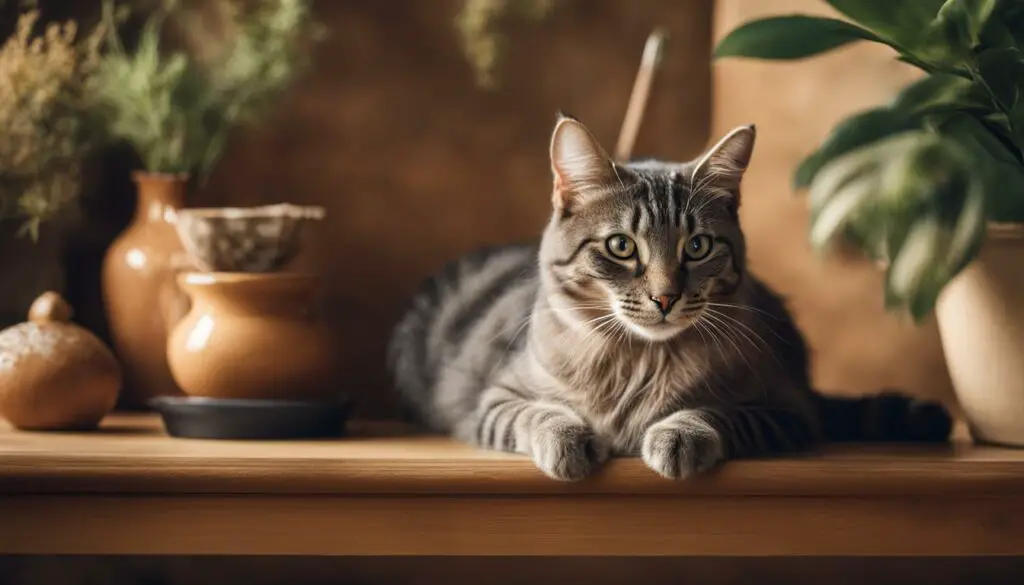
Signs of Affection from Cats
Cats are known for their mysterious and independent nature, but they also have a deeply affectionate side. Understanding the signs of affection that cats display can help owners strengthen their bond with their feline companions. Here are some common gestures that indicate love and attachment from cats:
- Kneading: When a cat kneads its paws against a soft surface, it is a sign of contentment and comfort. This behavior often stems from kittenhood, as they would knead their mother’s belly to stimulate milk flow. Kneading is a way for cats to show their love and trust towards their owners.
- Head-Butting: Known as “bunting,” head-butting is a behavior where a cat gently bumps its head against a person or object. This action is a display of affection and marking territory. Cats have scent glands on their heads, and head-butting transfers their scent, leaving a comforting mark.
- Gifts: Cats may present their owners with small “gifts” such as toys, leaves, or even deceased prey. This behavior is a sign of trust and affection. It demonstrates that the cat sees their owner as a valued member of their “family” and wants to share their treasures.
- Sleeping Near You: Cats that choose to sleep close to their owners are showing their love and trust. By seeking proximity during vulnerable moments, such as sleep, cats are displaying their affection and reliance on their human companions.
These signs of affection vary from cat to cat, and some cats may exhibit different behaviors to express their love. It is essential for owners to recognize and appreciate these gestures as a testament to the strong bond between them and their feline friends. By reciprocating these signs of affection, owners can foster a loving and fulfilling relationship with their cats.
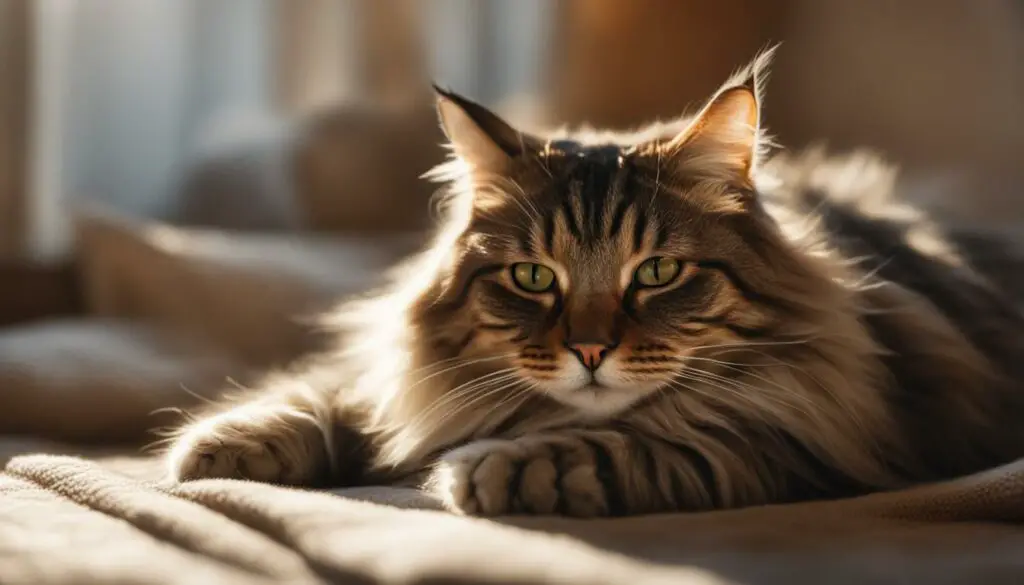
The Joy of Cat Cuddling
Cat cuddling is one of the most cherished expressions of feline affection. When a cat chooses to cuddle up with its owner, it signifies a deep level of trust, comfort, and love. Cuddling provides a sense of security for both the cat and the owner, enhancing the bond between them.
Cats have their unique ways of cuddling, such as curling up on their owner’s lap or nuzzling their face against their owner’s neck. These cozy moments create a shared warmth and closeness that solidifies the emotional connection between cat and human.
While some cats may be more inclined to cuddle than others, it is crucial for owners to respect their cat’s boundaries. Cats enjoy their personal space and may not want to cuddle at all times. By understanding and honoring their preferences, owners can ensure a harmonious and fulfilling cuddling experience.
| Cuddling Benefits | Cuddling Etiquette |
|---|---|
|
|
Vocal Communication of Cats
When it comes to communication, cats have a wide range of vocalizations. From meowing to purring and even chattering, these sounds express their feelings and desires. Meowing is perhaps the most common way cats communicate with their owners, and it can mean various things depending on the context.
Table: Cat Vocalizations
| Vocalization | Meaning |
|---|---|
| Meowing | Requesting attention, hunger, or greeting |
| Purring | Expressing contentment and relaxation |
| Chattering | Showing excitement or frustration |
“Meowing is a versatile vocalization that cats use to communicate their needs. It can be a way of getting attention, whether it’s demanding to be let outside or requesting food,” says Dr. Jane Miller, a feline behavior expert. “Purring, on the other hand, is often associated with contentment and relaxation. Cats will purr when they are feeling comfortable and safe.”
In addition to meowing and purring, cats may also exhibit chattering. This peculiar sound, which resembles a mix of chirping and teeth chattering, is commonly observed when cats see prey, such as birds or squirrels, through a window. It is believed to be a sign of frustration or excitement caused by their instinctual hunting behavior.
Understanding these vocalizations is essential for cat owners to better interpret their pet’s needs and emotions. By paying attention to the context and accompanying body language, we can foster stronger bonds with our feline companions and ensure their well-being.
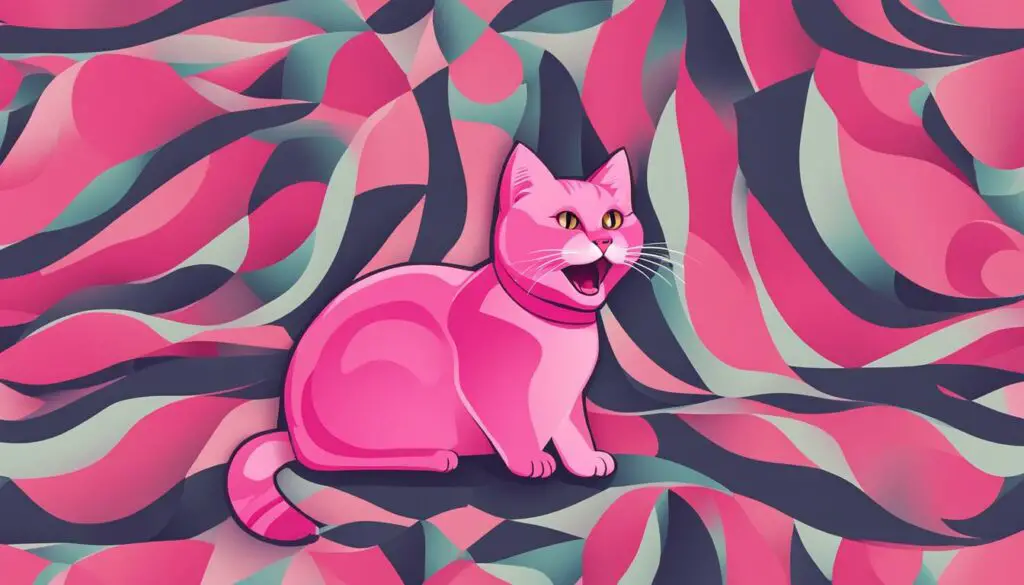
Exclusive Grooming Rituals
Grooming is an essential aspect of a cat’s daily routine, not only for maintaining their hygiene but also for strengthening the bond between cats and their owners. Cats engage in mutual grooming as a sign of trust, affection, and social bonding. This grooming ritual involves cats licking and nibbling each other, removing dirt and parasites from their fur, and providing a sense of comfort and security.
When cats invite their owners to participate in grooming rituals, it is a special gesture of love and acceptance. By allowing their owners to groom them, cats are displaying their trust and vulnerability. It is a bonding experience that strengthens the connection and deepens the affection between cats and their human companions.
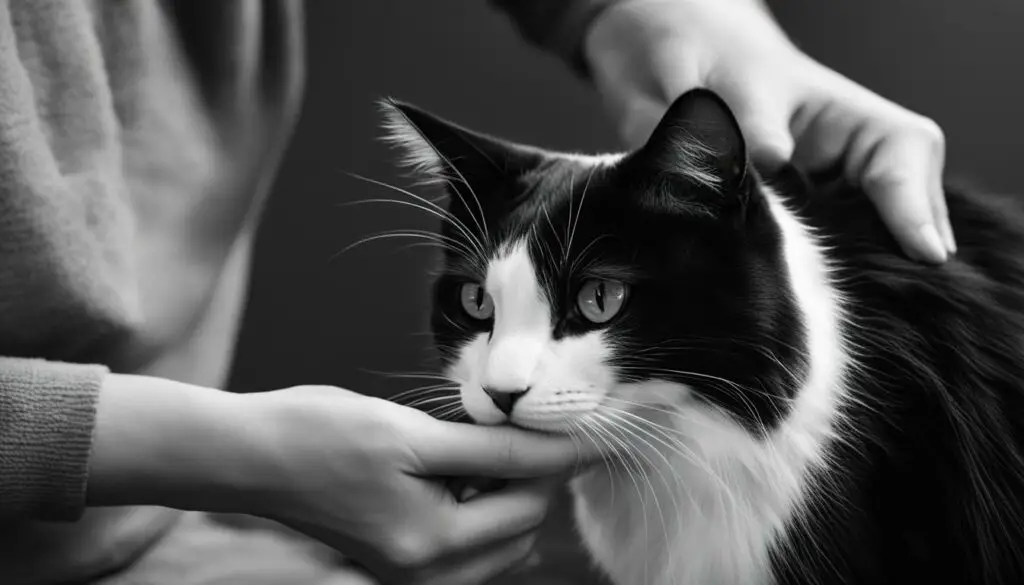
The Benefits of Mutual Grooming
The mutual grooming ritual not only strengthens the bond between cats and their owners but also provides several benefits for both parties involved. For cats, grooming helps distribute natural oils throughout their fur, keeping it shiny and healthy. It also stimulates blood circulation, which promotes overall well-being. Additionally, grooming allows cats to express their nurturing instincts and offers a sense of relaxation and pleasure.
For cat owners, participating in grooming rituals with their feline companions offers a chance to demonstrate care and affection. It creates a shared experience that deepens the emotional connection and fosters a sense of trust. Grooming sessions also provide an opportunity to check for any abnormalities in the cat’s skin or fur, allowing for early detection of potential health issues.
Encouraging Mutual Grooming
To encourage mutual grooming, cat owners can create a calm and comfortable environment that promotes relaxation. Soft brushing or gentle strokes can evoke the sensation of grooming and mimic the actions of a fellow cat, encouraging the cat to engage in reciprocal grooming behavior. It is important to pay attention to the cat’s body language and provide positive reinforcement, such as treats or praise, to reinforce the bonding experience and encourage future grooming sessions.
| Benefits of Mutual Grooming | How to Encourage Mutual Grooming |
|---|---|
| Strengthens the bond between cats and their owners | Create a calm and comfortable environment |
| Promotes healthy and shiny fur | Use gentle brushing or strokes |
| Stimulates blood circulation and overall well-being | Pay attention to the cat’s body language |
| Expresses nurturing instincts and relaxation | Provide positive reinforcement |
Attachment Behaviors of Cats
When it comes to cats, their attachment to their owners can sometimes be overwhelming. Imprinted cats often exhibit behaviors that showcase their strong bond and need for companionship. From following their owners everywhere to demanding attention and displaying distress when separated, these actions are clear signs of their deep attachment.
Cat owners may experience their feline friends constantly by their side, seeking physical closeness and reassurance. This clinginess can manifest in behaviors such as rubbing against legs, snuggling on laps, and even trying to share the same personal space. It’s important to understand that these attachment behaviors stem from the cat’s need for security and affection.
Some cats may engage in attention-seeking behaviors to ensure they remain the center of their owner’s world. From meowing incessantly to pawing at their owners, cats may use various strategies to capture their attention. While this behavior can be endearing, it’s crucial to find a balance between fulfilling the cat’s need for affection and respecting their personal space.
Table: Cat Attachment Behaviors
| Attachment Behavior | Description |
|---|---|
| Following owners everywhere | Cats may constantly shadow their owners, always staying close to them. |
| Demanding attention | Cats may engage in attention-seeking behaviors to capture their owner’s focus. |
| Displaying distress when separated | Cats may become visibly upset or anxious when separated from their owners. |
| Clinging and physical closeness | Cats may exhibit clingy behavior, seeking physical contact and reassurance from their owners. |
Understanding and responding to these attachment behaviors is essential for maintaining a healthy and fulfilling relationship with your cat. It is important to provide them with the love and attention they seek while also respecting their personal space and boundaries. By finding the right balance, you can strengthen the bond with your cat and ensure a harmonious connection.
Respecting Personal Space
When it comes to our furry feline friends, it’s important to remember that cats have their own boundaries and appreciate respect for their personal space. Understanding their need for independence helps maintain a harmonious relationship between humans and cats.
Cats are known for their independent nature, and while they may enjoy our company, they also value their alone time. It’s essential to recognize when a cat wants space and allow them to retreat to their favorite cozy corner or hiding spot. Providing them with their own designated area where they feel safe and secure can help foster a sense of trust and security.
Just like humans, cats have different personalities and varying levels of comfort with physical contact. While some cats may enjoy being petted and cuddled, others may prefer minimal touch or simply being in the same room as their owners. It’s crucial to observe and respect their body language cues, such as tail flicking or flattened ears, which may indicate that they need some space.
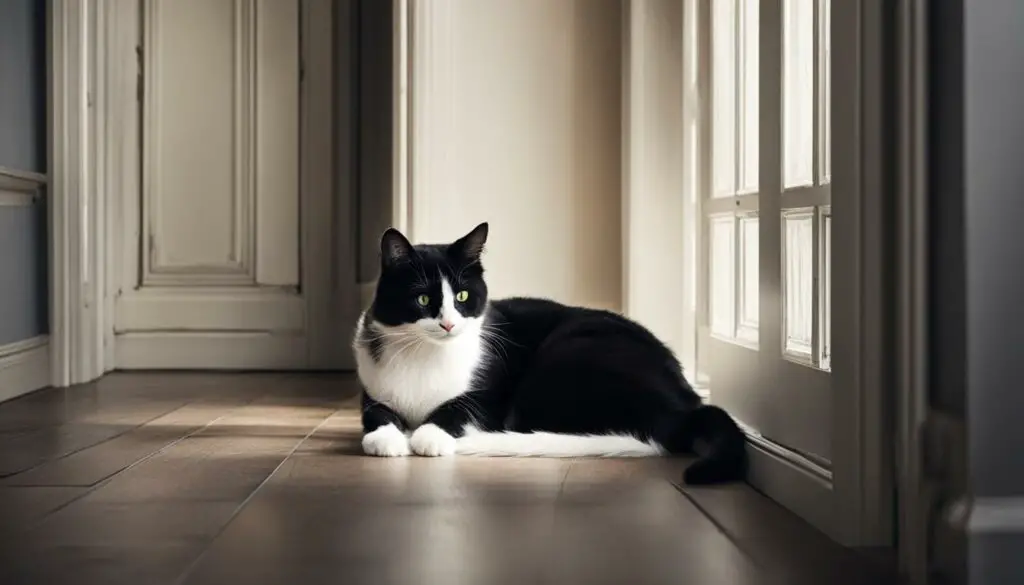
I’ve always believed in giving my cat, Whiskers, her personal space. When she retreats to her favorite spot under the bed, I know it’s her way of recharging and having some alone time. Respecting her boundaries has allowed us to build a strong bond based on trust and understanding.” – Cat Owner
Creating a Cat-Friendly Environment
In addition to respecting their personal space, creating a cat-friendly environment can also help ensure their comfort and independence. Providing vertical spaces, such as cat trees or shelves, allows cats to observe their surroundings from a higher vantage point and satisfy their natural instinct to climb and explore.
Offering multiple hiding spots, cozy beds, and scratching posts can create a sense of security and provide cats with options for retreat when they desire solitude. Additionally, interactive toys and puzzle feeders can keep cats mentally stimulated and engaged, allowing them to exercise their natural hunting instincts.
By understanding and respecting a cat’s personal space, we can foster a healthy and mutually beneficial relationship. It’s important to remember that cats are individuals with unique preferences and behaviors, and by acknowledging their need for independence, we can build a relationship based on trust and respect.
Cats Sensing Your Emotions
It’s no secret that cats are incredibly perceptive creatures. Not only do they have an uncanny ability to sense our emotions, but they also provide a comforting presence when we need it the most. Whether you’re feeling down, stressed, or anxious, your feline friend is there to offer emotional support and a listening ear – or rather, a listening purr.
Cat empathy is a remarkable phenomenon that highlights the deep bond and understanding between cats and their owners. When we’re feeling sad, cats often come close, rubbing against our legs, purring softly, or curling up beside us. Their comforting presence can help reduce stress and provide a sense of calmness, creating a soothing environment that helps us cope with our emotions.
Research has shown that the purring sound produced by cats has a therapeutic effect on humans. The low-frequency vibrations of a cat’s purr can have a positive impact on our physical and mental well-being. It has been found to lower blood pressure, reduce stress levels, and promote relaxation. This innate ability to sense our emotions and provide comfort is one of the many reasons why cats make such wonderful companions.
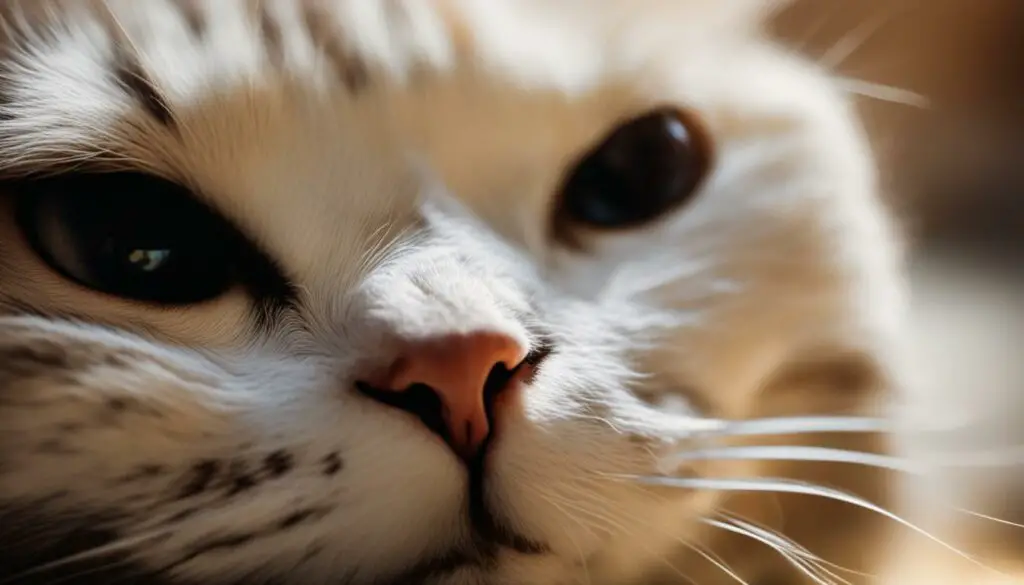
Quotes
I always thought my cat had a sixth sense when it came to my emotions. Whenever I’m feeling down, she curls up on my lap and purrs as if she’s trying to tell me that everything will be okay. It’s incredibly comforting to have a furry friend who understands me so well.
Studies have shown that cats have a heightened ability to sense our emotions. Their empathetic nature allows them to provide emotional support during difficult times. It’s amazing how a simple act of curling up beside you can make you feel less alone and more understood.
Table: How Cats Sense and Respond to Emotions
| Emotion | Cat’s Response |
|---|---|
| Sadness | Offering physical comfort, purring |
| Anxiety | Providing a calming presence, gentle headbutting |
| Stress | Reducing stress through purring vibrations, kneading |
| Happiness | Displaying affectionate behaviors, playful antics |
As much as we provide love and care for our feline companions, they also reciprocate by being attuned to our emotional needs. The cat-human bond goes beyond words and is built on a foundation of empathy, trust, and understanding. So the next time you’re feeling down, don’t hesitate to turn to your furry friend for some much-needed emotional support.
Imprinting in Training and Behavior
When it comes to training our cats, understanding the concept of imprinting is crucial. Imprinting refers to the deep emotional bond that cats form with their owners, resulting in unique behaviors and signs of attachment. By leveraging positive reinforcement techniques, we can foster a stronger bond and nurture positive behavior in our feline companions.
The Power of Positive Reinforcement
Positive reinforcement is a highly effective training method for imprinted cats. This technique involves rewarding desired behaviors with treats, praise, or playtime, reinforcing the idea that such behaviors lead to positive outcomes. For example, when our cat uses the litter box correctly, we can offer a treat or words of encouragement. Over time, our cat will associate the desired behavior with positive reinforcement, making it more likely to repeat it.
By using positive reinforcement, we create a harmonious training environment and build trust with our cats. It also helps establish clear boundaries and expectations, making it easier for cats to understand what is expected of them. This approach not only strengthens the human-cat relationship but also enhances the well-being of our feline friends.
Integrating Training into Everyday Interactions
Training should not be limited to formal sessions but integrated into our everyday interactions with our cats. Every mealtime, play session, or grooming session is an opportunity to reinforce positive behavior and strengthen the bond. For example, during playtime, we can reward our cats with treats for exhibiting appropriate play behavior or engaging with interactive toys.
It’s important to be patient and consistent when training our cats, as each cat has its own learning pace. Remember to keep training sessions short and enjoyable, avoiding any negative reinforcement or punishment. This way, we create a positive learning environment that motivates our cats to participate and learn new behaviors.
| Benefits of Positive Reinforcement Training | Examples |
|---|---|
| Strengthens the bond between human and cat | Using treats to reward desired behaviors |
| Nurtures positive behavior | Praising and petting for using the scratching post |
| Builds trust and mutual understanding | Offering treats when the cat comes when called |
By using positive reinforcement in training our cats, we not only shape their behavior but also create a loving and respectful relationship. Imprinting plays a significant role in this process, as it strengthens the bond between human and cat, fostering a harmonious and enriching companionship.
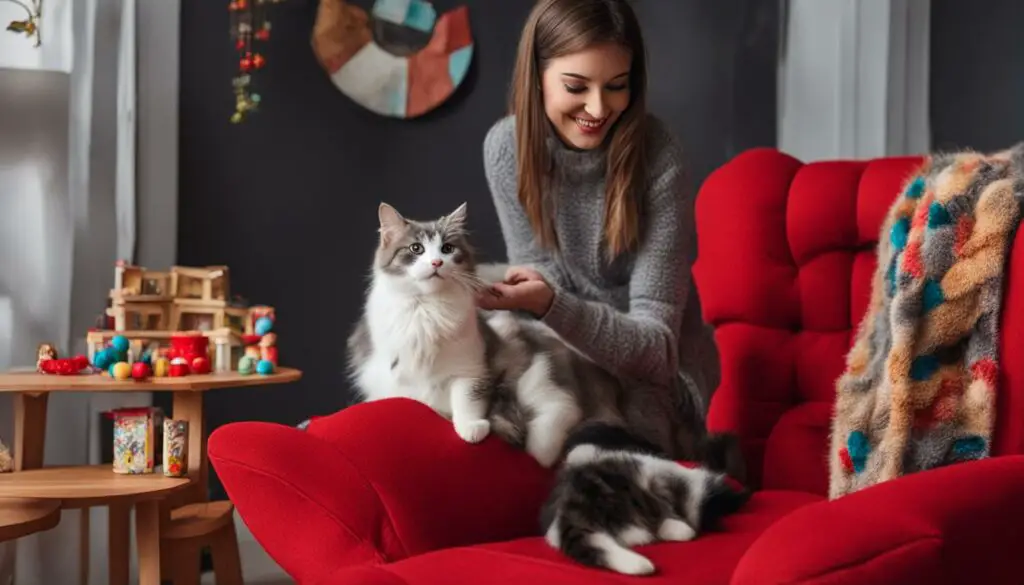
Reciprocity in Human-Cat Imprinting
As cat owners, we often marvel at the deep bond and affection that our feline friends display towards us. But have you ever wondered about the role we play in shaping this special connection? The concept of cat imprinting emphasizes the reciprocal nature of the human-cat bond, highlighting how our actions and interactions influence their behavior and attachment towards us.
When we provide our cats with love, care, and attention, we foster a sense of security and trust in their hearts. This reciprocation is vital in maintaining a strong human-cat imprinting and deepening the emotional connection between us. By responding to their needs, understanding their body language, and respecting their boundaries, we create an environment that nurtures their affectionate behavior and reinforces their attachment to us.
The reciprocation in human-cat imprinting is a beautiful synergy that brings immense joy and fulfillment to both parties. When we shower our cats with love, they respond with their own unique displays of affection, be it through gentle head-butting, cozy cuddles, or playful grooming rituals. These actions not only showcase their deep attachment but also serve as a reminder of the mutual love and companionship we share.
The Power of Positive Reinforcement
Positive reinforcement plays a crucial role in shaping the reciprocation in human-cat imprinting. By rewarding desirable behavior, such as using treats and praise, we reinforce the bond and encourage our cats to continue engaging in affectionate actions. This positive feedback loop strengthens the emotional connection and builds a foundation of trust and love between humans and cats.
| Actions to Strengthen Human-Cat Imprinting | Actions to Avoid |
|---|---|
|
|
In summary, human-cat imprinting thrives on reciprocity, where our actions and interactions shape the bond we share with our feline companions. By nurturing their affectionate behavior, respecting their boundaries, and using positive reinforcement, we can create a harmonious and loving relationship that brings immense joy to both us and our beloved cats.
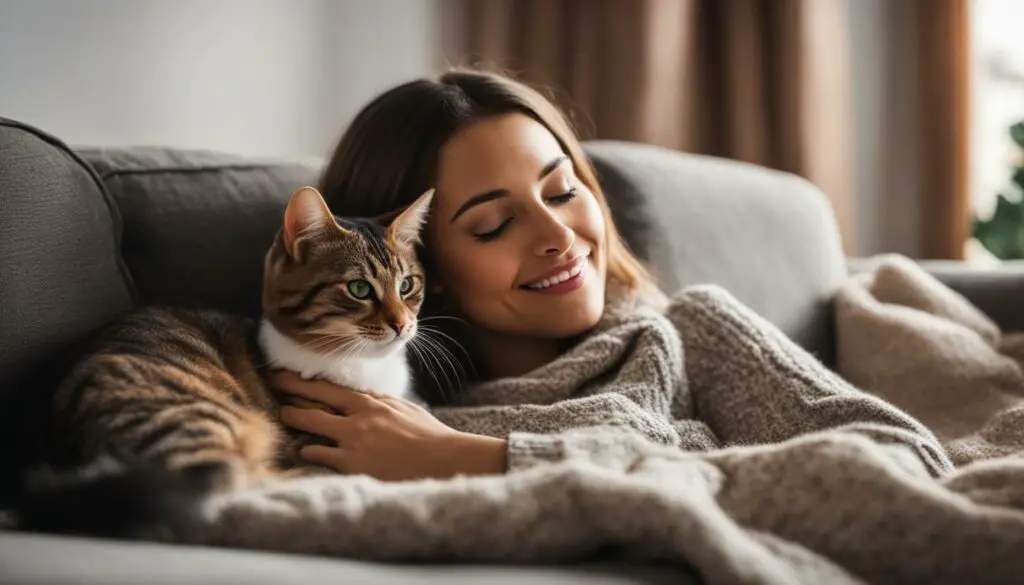
Conclusion: Nurturing Your Cat’s Imprinted Love
Understanding and nurturing your cat’s imprinted love is key to fostering a strong and fulfilling bond. Cats, with their unique behaviors and gestures, express their affection towards their owners in various ways.
By observing their body language, such as tail movements and ear positions, we can decipher their emotions and respond accordingly. Cats also show their love through actions like kneading, head-butting, and sleeping near their favorite humans. These gestures signify their attachment and adoration.
Respecting their personal space is crucial in maintaining harmony. Cats appreciate having boundaries and value their independence. By showing respect for their personal space, we can build trust and strengthen the emotional connection.
Cats have an incredible ability to sense our emotions and provide us with comfort and support when we need it most. This unique bond goes beyond the surface and becomes a true emotional connection between humans and felines.
To nurture this special bond, positive reinforcement training methods can be used. By training our cats and reinforcing positive behaviors, we not only enhance their training but also deepen the human-cat relationship.
Remember, nurturing your cat’s imprinted love is a continuous process. By recognizing and responding to their affection, understanding their behaviors, and providing love and care, we can create a lasting and fulfilling relationship with our feline companions.
FAQ
Do all cats want to be petted constantly?
No, not all cats want constant petting. Some cats may prefer certain types of affection or enjoy independent playtime.
How do I know if my cat is imprinted on me?
Signs of cat imprinting include following you around, demanding attention, and showing distress when separated. These behaviors indicate a strong bond.
What are some common cat body language gestures?
Cats communicate through body language such as purring, tail movements, eye expressions, and ear positions. Understanding these cues can help decipher their emotions and affection.
How do cats show their affection?
Cats show affection through behaviors like kneading, head-butting, presenting gifts, and sleeping near their owners. These actions signify their love and attachment.
What do different cat vocalizations mean?
Cats use vocalizations like meowing, purring, and chattering to communicate with their owners. These sounds express their feelings of contentment, excitement, and communication.
Why do cats groom each other?
Cats engage in mutual grooming as a sign of trust and affection. They may also nibble playfully and invite their owners to participate in grooming rituals.
Do all cats have attachment behaviors?
Cats with strong imprints may exhibit attachment behaviors like following their owners, demanding attention, and displaying distress when separated. These actions show their strong bond and need for companionship.
How can I respect my cat’s personal space?
Cats have boundaries and appreciate respect for their personal space. Understanding their need for space helps maintain a harmonious relationship. Give your cat space when they indicate they need it.
Can cats sense human emotions?
Yes, cats have the ability to sense their owner’s emotions and provide comfort in times of distress. They offer emotional support and celebrate joys together.
How can training strengthen the cat-human bond?
Imprinted cats respond well to positive reinforcement training methods. Bonding through training strengthens the human-cat relationship and nurtures positive behavior.
How does human behavior impact cat imprinting?
Human actions impact cat imprinting, and nurturing the bond through care and affection deepens the emotional connection between humans and cats.

